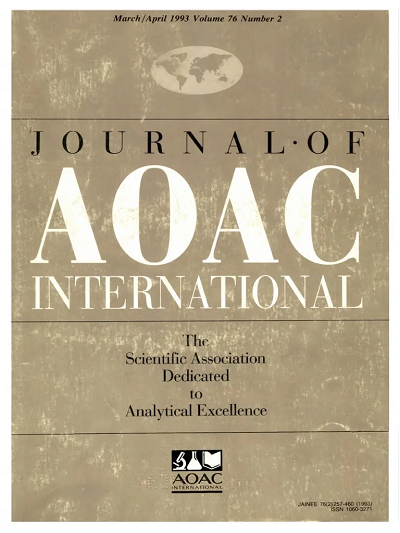Comparison of Roka Atlas® System Performance and Health Canada Reference Method for Listeria Detection from Plastic, Sealed Concrete, and Stainless Steel Surface Samples
IF 1.7
4区 农林科学
Q3 CHEMISTRY, ANALYTICAL
引用次数: 0
Abstract
Background There is a high demand in food industry and public health for rapid automated methods capable of high volume sample processing. Objective In an unpaired study Roka Atlas® System performance was compared with Health Canada reference method MFHPB-30 for Listeria spp. (LSP Roka assay) and Listeria monocytogenes (LmG2 Roka Assay) detection on plastic (PL), sealed concrete (SC), and stainless steel (SS) surfaces (45 samples each per candidate or reference method). Methods Seeking shorter enrichment time for the candidate method, R2 medium pre-enrichment for 14, 16, and 24 h at 35 °C was combined with the Roka assay. Listeria welshimeri, L. innocua, and L. monocytogenes were employed to individually inoculate each of the three surfaces, with two competing microorganisms within the 10–100 fold higher concentration range. Results False negative, false positive, sensitivity and specificity were 0, 0, 100, and 100%, respectively, for the plastic, sealed concrete, and stainless steel surfaces, regardless of inoculation level (high, low, and uninoculated) and enrichment time. Candidate method detected 10, 7 and 9 true positives, versus 10, 6 and 10 by the reference method in individually inoculated SS, PL and SC, respectively. Conclusion Probability of detection for all the three surfaces for the Roka Atlas® System was comparable to the reference method, in this unpaired study. Highlights The Roka Atlas® System detected targets after as little as 14 h enrichment. Surface type did not negatively affect assay sensitivity or specificity. The Roka Atlas® System was comparable to the reference method.从塑料、密封混凝土和不锈钢表面样品中检测李斯特菌的 Roka Atlas® 系统性能与加拿大卫生部参考方法的比较
背景 食品工业和公共卫生领域对能够进行大量样品处理的快速自动方法有很高的需求。目的 在一项非配对研究中,比较了 Roka Atlas® 系统与加拿大卫生部参考方法 MFHPB-30 在塑料 (PL)、密封混凝土 (SC) 和不锈钢 (SS) 表面(每种候选方法或参考方法各 45 个样品)上检测李斯特菌属 (LSP Roka 检测法) 和单核细胞增生李斯特菌 (LmG2 Roka 检测法) 的性能。方法 为了缩短候选方法的富集时间,R2 培养基在 35 °C、14、16 和 24 小时的预富集与罗卡检测相结合。采用韦氏李斯特菌、无毒李斯特菌和单核细胞增生李斯特菌分别接种于三个表面,两个竞争微生物的浓度范围在 10-100 倍以上。结果 无论接种水平(高、低和未接种)和富集时间如何,塑料、密封混凝土和不锈钢表面的假阴性、假阳性、灵敏度和特异性分别为 0、0、100 和 100%。在单独接种的 SS、PL 和 SC 中,候选方法分别检测出 10、7 和 9 个真阳性,而参考方法分别检测出 10、6 和 10 个真阳性。结论 在这项非配对研究中,Roka Atlas® 系统对所有三种表面的检测概率与参考方法相当。亮点 Roka Atlas® 系统只需经过 14 小时的富集就能检测到目标物。表面类型不会对检测灵敏度或特异性产生负面影响。Roka Atlas® 系统与参比方法具有可比性。
本文章由计算机程序翻译,如有差异,请以英文原文为准。
求助全文
约1分钟内获得全文
求助全文
来源期刊

Journal of AOAC International
医学-分析化学
CiteScore
3.10
自引率
12.50%
发文量
144
审稿时长
2.7 months
期刊介绍:
The Journal of AOAC INTERNATIONAL publishes the latest in basic and applied research in analytical sciences related to foods, drugs, agriculture, the environment, and more. The Journal is the method researchers'' forum for exchanging information and keeping informed of new technology and techniques pertinent to regulatory agencies and regulated industries.
 求助内容:
求助内容: 应助结果提醒方式:
应助结果提醒方式:


